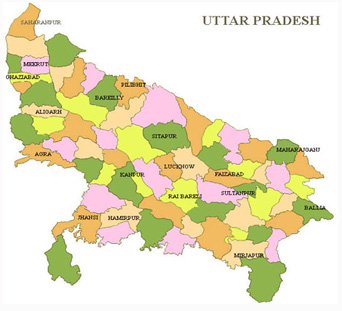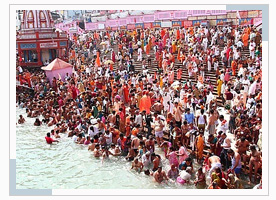Uttar Pradesh
Tourism of Uttar Pradesh has attracted the tourists from all over the world for cultural diversities with multi-religious societies, variety of geographical land, variety of cuisines dotted with various holy shrines and pilgrim places, historical monuments, expanses of meadows, perennial rivers, dense forest and fertile soil.Uttar Pradesh was the centre of heroic  activities of Rama, Krishna, Buddha, Mahavira, Ashoka and Harsha during the ancient period; Akbar, Jahangir and many other Nawabs during the medieval period; and Motilal Nehru, Jawaharlal Nehru and other leaders during the modern time. The state of Uttar Pradesh occupies the prime location in the map of India as it shares its borders with Bihar to the East, Madhya Pradesh to the South, Rajasthan, Delhi, Himachal Pradesh and Haryana to the west and Uttaranchal to the north and Nepal to its northern borders.
activities of Rama, Krishna, Buddha, Mahavira, Ashoka and Harsha during the ancient period; Akbar, Jahangir and many other Nawabs during the medieval period; and Motilal Nehru, Jawaharlal Nehru and other leaders during the modern time. The state of Uttar Pradesh occupies the prime location in the map of India as it shares its borders with Bihar to the East, Madhya Pradesh to the South, Rajasthan, Delhi, Himachal Pradesh and Haryana to the west and Uttaranchal to the north and Nepal to its northern borders.
Tourist Attractions of Uttar Pradesh
The tourist attractions of Uttar Pradesh can be divided into three distinct hypsometry regions – the tourist attractions in the Himalayan region of the Northern Zone; tourist attractions around Gangetic Plain in the Central Zone and the Vindhya Hills and Plateau in the Southern Zone. The famous tourist attractions of the Himalayan Zone are Uttarkashi, Chamoli, Pithoragarh, Tehri-Garhwal, Garhwal, Almora, Nainital, Dehradun with other attractions of Badrinath, Kedaranath Banarpunch, Mount Kamety, Trishul, Dunagiri, Nanda Devi, Siwalik Range etc. The tourist attractions around Gangetic Plain of Uttar Pradesh are based on river tourism comprised of Jamuna, the Ganga and its major tributaries, the Ramganga, the Gomati, the Ghaghra and Gandak, Vindhya hills and plateau.
 Historical Monuments in Uttar Pradesh
Historical Monuments in Uttar Pradesh
Uttar Pradesh is dotted with diversified historical monuments scattered all over the regions from north to south and east to west. Some of the famous historical monuments of Uttar Pradesh among them some are UNESCO World Heritage Sites are Taj Mahal in Agra – one of the wonder’s of the world, Akbar’s Tomb, Itmad-ud-Daulat’s Tomb, Agra Fort in Agra; Panch Mahal, Ankh Micholi Treasury, Tomb of Salim Chisti, Palace of Jodha Bai, Diwan-I-Khas, Diwan-I-Aam, Birbal Bhawan in Fatehpur Sikri; Bara Imambara, Tombs of Sa'adat Ali Khan, Lucknow Residency, La Martiniere, Clock Tower, Kaiserbagh Palace, Shah Najaf Imambara in Lucknow; Shri Krishna Janmbhoomi, Rangbhoomi, Vishram Ghat, Potara Kund, Sati Burj, Kans Fort in Mathura; Kesi Ghat, Vrindavan Parikrama in Vrindavan; Ram Nagar Fort, Dasaswamedh Ghat, Banares Hindu University, Assi Ghat, Manikarnika Well, Bachraj Ghat, Dandi Ghat, Hanuman Ghat, Gyaan Kupor Well, Tomb of Lal Khan in Varanasi; Ramkot Citadel, Sumantanath in Ayodhya; Mulagandhakuti, Anathapindikas Stupa, Angulimala Stupa in Shravasti, Chaukhandi, Dhamek Stupa in Sarnath; Allahabad Fort, Anand Bhavan in Allahabad; Moti Mahal, Fort Kolkata in Faizabad etc.
Religious Tourism in Uttar Pradesh
The land of Uttar Pradesh is the fusion of different religions, cultures, history, traditions reflected during the fairs and festivals based on the concepts of religions. The famous pilgrimage centres of Uttar Pradesh are Allahabad which is located at the confluence of the rivers Ganga, Yamuna and the mythical Saraswati famous all over the world for the Kumbh and Ardh Kumbh Melas held every twelve and six years respectively; Varanasi situated on the banks of the Ganges is popular among the Shivites along with various known holy places and around 100 Ghats are located for holy dip; the pilgrimage centre of Mathura is widely known as birth place of lord Krishna with other pilgrimage centres like Nandgaon and Vrindavan as both are associated with the life of Lord Krishna. Some other pilgrimage centres are Ayodhya, Sarnath, Kushinagar, Shravasti, Kedarnath, Badrinath, Rishikesh, Garhmukteshwar, Dewa Sharif, Kaushambi, Barelvi Sufi Order, mazaar of Sufi saint Hazrat Salim Chisti at Fatehpur Sikri, Dewa Sharif near Lucknow etc.
- Agra
- Aligarh
- Allahabad
- Ambedkar Nagar
- Auraiya
- Azamgarh
- Bagpat
- Bahraich
- Ballia
- Balrampur
- Banda
- Barabanki
- Bareilly
- Basti
- Bijnor
- Budaun
- Bulandshahar
- Chandauli
- Chitrakoot
- Deoria
- Etah
- Etawah
- Faizabad
- Farrukhabad
- Fatehpur
- Firozabad
- Gautam Buddha Nagar
- Ghaziabad
- Ghazipur
- Gonda
- Gorakhpur
- Hamirpur
- Hardoi
- Hathras
- Jalaun
- Jaunpur
- Jhansi
- Jyotiba Phule Nagar
- Kannauj
- Kanpur
- Kanpur Dehat
- Kaushambi
- Kheri
- Kushinagar
- Lalitpur
- Lucknow
- Maharajganj
- Mahoba
- Mainpuri
- Mathura
- Mau
- Meerut
- Mirzapur
- Moradabad
- Muzaffarnagar
- Pilibhit
- Pratapgarh
- RaeBareli
- Rampur
- Saharanpur
- Sant Kabir Nagar
- Sant Ravidas Nagar
- Shahjahanpur
- Shravasti
- Siddharthnagar
- Sitapur
- Sonbhadra
- Sultanpur
- Unnao
- Varanasi
- Sarnath
- Jhansi





